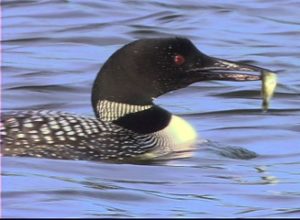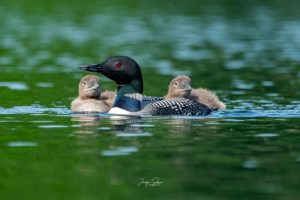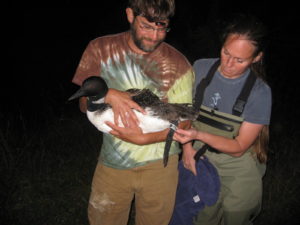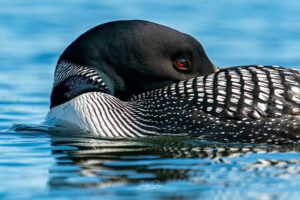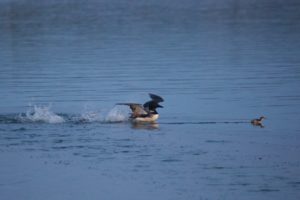The Loons of Round Lake
The Common Loon is typically found in wilderness areas such as Minnesota’s Boundary Waters, so Lakeside Club owners are fortunate to be able to watch loons on Round Lake, which is currently home to a nesting pair of Common Loons and receives occasional visits by non-resident loons.
Loons are very distinctive birds. The head of a mature Common Loon is jet black, with striking red eyes and a pointed black beak. Its plumage is a harmonious composition of contrasting black and white patterns. On the neck is a wedge-shaped band of narrow zebra-like vertical stripes over a solid black ring. The breast is white in front, with curved zebra stripes behind merging into a black back checkered with squarish white blobs.
The weird, wild sounds of loon calls suggests that loons are ancient birds, as they are. An eerie wail helps loons locate one another. A wavering tremolo may indicate danger or announce a loon’s arrival at a lake. A yodeling call warns other loons to keep off the territory of a resident male loon. That warning call is not always effective—one of the two loon chicks that hatched on Round Lake in 2018 was killed by an invading loon.
Despite a torpedo-shaped body that enables it to fly at nearly 100 mph and dive to depths of 200 feet, the loon has a design flaw. Its legs are so far back on the body that it needs a long runway to get up enough speed to take flight. Loons can barely walk at all on land, so a loon that comes to earth some distance from a substantial body of water may be stranded and die.
It’s encouraging to know that loons can survive in places close to human habitation as well as wilderness areas, but there are a number of conditions that threaten their existence. Loons are carnivores who eat mostly fish and other aquatic creatures, so they may starve because of reduced fish populations, or ingest lead sinkers that have been swallowed by fish and die of lead poisoning. Pollutants such as fertilizer runoff can damage a lake’s habitat to the point where loons can no longer breed or survive. PWCs and other watercraft can drive loons from their nesting sites, wash eggs and chicks off a nest with their wakes, or even run over and kill them.
Photo by Jenifer Selwa
Loons are an indicator species whose presence on a lake indicates that the lake is healthy. To keep Round Lake healthy and keep the loons coming back to it, Lakeside Club members and other residents of lake property should follow some commonsense guidelines. Keep boats well away from places where the loons are swimming, especially nesting areas, which are marked by distinctive buoys. It’s best to watch them from at least 200 feet away, using binoculars or a spotting scope. Don’t fish or cast near loon nests or swimming loons, avoid the use of lead sinkers, and pick up monofilament fishing line in which loons can become entangled. Never throw trash into the lake, especially plastic items that might trap a loon. And don’t walk your dog anywhere near a potential loon nesting area.
LoonCorps
LoonCorps is a local organization dedicated to protecting and preserving loon nesting areas. The founder of LoonCorps is Jeff Lange who, with a crew of volunteers, built an artificial nesting island (ANI) and moored it on one end of Round Lake. Loons and their chicks are very vulnerable to predators, especially when they nest on shore, so the ANI provides a reasonably safe and secure place to raise a loon family. Loon nesting areas are also protected by warning buoys to prevent boaters from approaching the loons too closely.
Tagging a Loon
LoonCorps is an all-volunteer organization so it needs help to place and maintain the artificial nesting islands and warning buoys it sets up every year, and to report observations of loon activities either from the shore or by boats.
Sadly, Jeff Lange passed away unexpectedly on February 26, 2019, doing what he loved most, enjoying nature outdoors. The Loon Corps website looncorps.wordpress.com is no longer maintained but it still contains information and videos about loons, many of them on Round Lake. Go to Uncommon Loon to see a trailer from Jeff’s video about the loons of Round Lake. You can purchase the video by contacting Lee Anne Whitman at musicalmaidens@yahoo.com or (231) 330-9137.
Loons aren’t the only fascinating creatures in the area around Lakeside Club. Check out Jeff’s Video about the inhabitants of nearby wetlands.
More about Loons from Bud Siudara
April 6, 2022. Somewhere on the near shore of the Gulf of Mexico, a pair of common loons is getting restless. Something in their internal calendar – probably hormone secretion – is telling each of them “Get ready, it’s time to go.” The annual infusion of chemicals begins in April and compels the pair to begin a 1,250 mile flight to Round Lake and arrive days after ice-out in mid-April. Loons are among the fastest fliers at 70 mph. A non-stop flight would last 18 hours. But fishing stops along the way north are expected. So is landing first on the open waters of the big lake waiting for the Round Lake thaw.
While the common loon is abundant in Wisconsin, Minnesota and Canada, they are for some reason uncommon in our state of 10,000 + lakes. Michigan can claim not much more than 350 nesting pairs. Their summer range begins about the latitude of Traverse City. Emmet County is home for maybe 4 pair. We are indeed fortunate to have our very own.
Loons can live for as long as 30 years and mate for life like migratory Canada Geese and Cardinals that stay with us all year.
Male and female loons have identical, striking markings. The male is a bit larger. Loons can’t walk on land. Their large web feet are their propellers and are too far back for walking on land. That’s why they build their nests at the shoreline. They use their wings to swoop up at water’s edge and build their nests. Their nests on shore are vulnerable to predators like skunks, raccoons and such.
Loons are deep divers known to fish at 100’ below the surface. They can stay under for as much as 90 seconds before surfacing. They swim underwater like a torpedo.
Females have two distinct calls: the familiar night-time “wail” which is their “I’m here- where are you?” locater call, and the “tremolo” which is the call given when upset, when warding off an encroaching loon visitor, and when people get too near. This is their only in-flight call. The male loon has one additional call: the complex “yodel” which is its mating call.
May 3, 2022. As Great Lakes Sailors would say, it was blowing “stink” out of the east when Sue and I arrived on Saturday afternoon, the 21st. The ice was out. An east wind is always an unpleasant wind full of left-handed low pressure. There wasn’t a car in the Lakeside parking lot or even at Toski. There wasn’t a chance that afternoon to check to see if our loons had arrived.
Sunday morning was pleasantly different. No wind, flat water, and a warm 65+ temp that suggested Spring is around the corner. At 9:00 I went on my deck with my trusty 7 x 35 mm long eyes in hand to search the lake looking for our annual visitors that I knew had arrived days before. This was a “first look” task I’ve been doing since 1998.
I wasn’t disappointed. There they were about 400 yds out in the lake separated by maybe 20 feet with their heads in the straight away classic loon look ahead. And then, as if to say hello, the male raised his head and let go with a vibrant tremolo mating call that’s heard infrequently from April – May. And then a few seconds later he let go with another. The male obviously had something in mind. What a special welcome!
Can it get better than this! How the loon pair comes back each year to Round Lake is a mystery of nature. Let’s hope they mate and have a chick or two. “EDC” (Early obstetrical short for “Estimated Date of Confinement”) is early July.
June 1, 2022. It was May 27th- Friday afternoon @ 4:00 as I sat at my desk overlooking the Lake from my perch on the upper level of Unit 50. Although today hasn’t been bad, it’s been a cold, foggy 4-5 days here at Lakeside with the heavy fog on the Lake each morning and the other day closing down the airport for the entire morning. The air off the big lake has been so cold.
I had just received an email from Peggy Millard, a local Loon Ranger who lives on the north shore. She inquired if the Loons were on the nest. I replied “no”, it was a bit early, but getting close.
But then, no more than 30 minutes later- I heard really close the male Loon’s “tremolo” – the strong mating call. I went down one level and grabbed my “long eyes”. And there I saw something I had not seen before in so many years on the lake. One Loon was chasing another madly (3-feet separation) with wings flapping and I assume both propeller feet churning. My first reaction was that “Mr. Hotspur” was on the hunt and his “Lady” who was playing “hard to get”. The chase went on for at least 8 minutes in and out right in front of me on the 50-yard line with the two loons doing short straight aways and fast turns – a water version of water “Top Gun”. The two birds were going as fast as loons can go with wings flapping on the water and web feet paddling furiously. The chase went for 10 minutes and came close a few moored boats.
And then I saw the 3rd loon – obviously the female who was watching all the attention. I was wrong. What I had been witnessing was the repulse of a rogue male who was trying to invade and score with the female. This stand involved at least 10-15 minutes before the three-some carried on to the south and out of my eye sight.
Ms. Female Loon is quite obviously not on the nest just yet. But surely, she’s getting ready. The question is with when and with whom.
On another interesting note, mute swans are back on Round Lake for the 1st time in many years. I saw a float of 5 paddling swans close to our shore two weeks ago. And today, I saw the same 5 on the far east side of the lake. Are they coming for the day and flying off? Don’t know. Always nice to see nature and swans are such handsome big birds. But swans and loons don’t get along. Never have! Swans don’t’ get along with anyone – just leave them alone and they look peaceful and pretty. But as pretty as they are, swans can be mean, hiss and spit if you get near them. Although the “mute swan” we have here (there are 4 or 5 swan specie variants) is so much bigger than a loon and can be very aggressive if confronted, my bet on any combat contest would be in favor on the common loon – a fast-swimming submerged torpedo spearing a swan from the underside. It’s not nice to mess around with a common loon.
The Loon Report
Reports of loon observations by Lakeside Club members will be appreciated: contact John Lehman at jwillehman@gmail.com.
Photo by Jenifer Selwa
2024
April 28. Ron Pool has installed a loon nest on Round Lake. He also fixed both floating nest platforms and the adjacent little island.
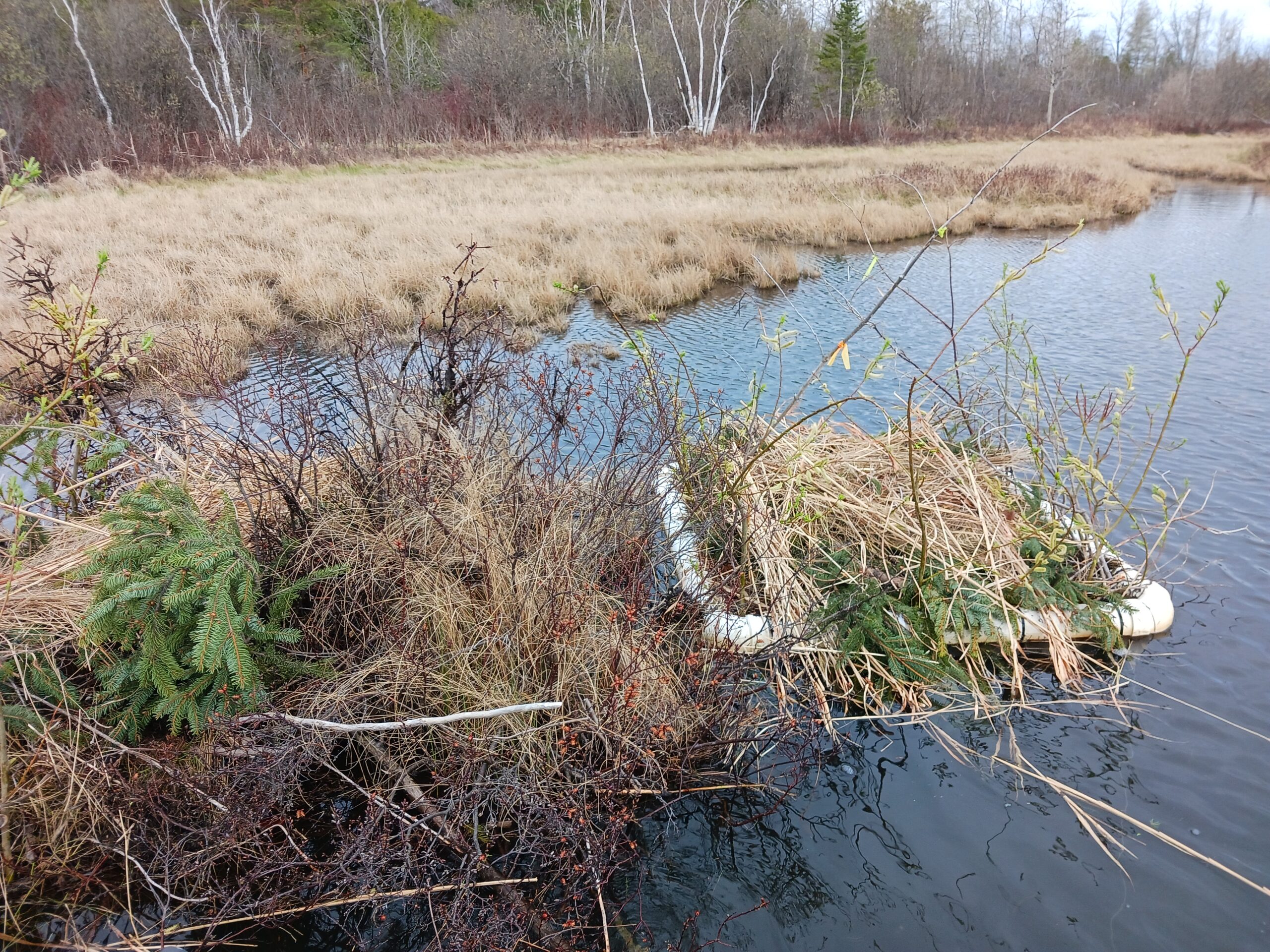
Photo by Ron Pool
May 2. A group of birders from the Petoskey Audubon Society spotted two Common Loons on the northern part of Round Lake.
July 1. From Bud Siudara: Ron Pool, a year-round lake resident, has assumed responsibility as chief loon ranger for the past few years. He revamped the loon nest in early May, making it really nice. We have no idea if the loons will nest, let alone have chicks. The incubation period is 30 days. If the adult loons are in a nesting mode, they should be on the nest right now. Typically, the chicks hatch in the last week of June or first week in July. Fingers crossed.
2023
May 2. According to Ron Pool, a pair of loons have been seen and heard on Round Lake. He has cleaned up both floating nests and used cedar limbs and spruce bows to make one of them look more like an island. The warning buoys may not go in until Memorial weekend or later, so please avoid going too close to the nesting area.
2022
May 5. Ron Pool reports that LoonCorps has been spotting the recent loon pair and that the two nests are prepared.
April 26. Bud Siudara reports that the loon pair has arrived on Round Lake and all is well.
April 6. According to Bud Siudara, 2022 begins the 34th year of the Round Lake Loon Watch and nest enhancement program.
2021
July 5. Ron Pool reports: We have seen 3 also at various time the last few weeks. Twice recently I have seen 5 in the early mornings, each time with some minor aggression. I inspected the raft and the small island nearby the other morning. No eggs or fragments, but could see they had been going on and off the natural island. Probability very very low for a successful nest this year, unless they lay eggs PDQ!
July 4. Bud Siudara reports: For the past several days, including this morning, the loon pair has been swimming, floating, diving in close harmony with a 3rd mature loon which I suspect by size is a female. No aggressive behavior. It’s clear the couple is a couple and the 3rd is a friendly newcomer. And I heard a tremolo the other morning in conjunction with several wails which is strange as the mating season should be over. Has this three-some been going on long?
June 20. Victor Wittkowski reports: I was out on my kayak this afternoon and checked the nests and didn’t see any eggs . But when I was at the far west end of the lake I saw a mature loon with an immature loon showing it to dive underwater. The first time I’ve seen the young one.
June 18. Peggy Millard reported seeing the pair of loons off the nest recently, which is not a good sign. Bud Siudara commented: Unless something crazy occurs with a late mate (which did happen years ago with an August birth), the pair swimming together in mid June means no nesting and no chicks this year.
June 6. A pair of loons is now nesting on Round Lake. Linda Rehor wrote “After seeing a lone Loon for at least 2 nights, I paddled over near nesting area and saw a Loon sitting upon a nest. Same spot as last year.” Ron Pool estimates that we should be seeing chicks around July 1. So please avoid the nesting area and watch out for the loons and their chicks on the lake.
April 25. According to Ron Pool, loons have been sighted on Round Lake. Loon Corps has positioned two nesting rafts and six new buoys on the lake.
2020
August 3. Bud Siudara: “A few nice days ago in the mid-morning out in the calm lake, I saw three pair of loons swimming and diving harmoniously floating and fishing. All 6 were close. watched for quite a while with my long eyes. I’ve never seen a floating squadron like that ever. I wonder if the loon word is out that Round Lake is the place to hang out.”
August 1. Peggy Millard: “Went for a kayak ride this morning and saw the baby loon swimming (and diving) all alone outside the buoys toward Lakeside but not that far. No adults anywhere in sight. As we got just about back to our house we heard a loon over in the nursery area by the west side of Powell Rd.”
July 19. Bud Siudara: “I saw the loon pair Friday morning heading north but without a chick? So disappointed. When was the last time anyone saw the chick?” Peggy Millard replied, “We saw the mom and chick yesterday in the loon nesting area before the big afternoon storm,” and later Linda Rehor wrote, “I saw the family this am in the nesting area after that early morning storm so all is good!”
July 6. Linda Rehor reports that the loon chick was left on its own this morning for least 3 hours. By late morning a single loon appeared and gave a few wails, and the chick then joined up with that loon.
June 28. Ron Pool reports: This morning we observed 5 loons on the lake. With my spotting scope I then saw 3 down in the nesting area. No hostile activity. All 3 finally flew off.I did notice two people on a pontoon pedal boat, which I believe reside at the condos, down at that far end just after all this went on. The pedal boat stayed outside the buoys. On the other hand a guy on a paddle board in one of the condos was definitely inside the buoys this am. Later Ron wrote “Just spotted loon and chick feeding just outside the buoys.”
June 22. Peggy Millard reports: “I just saw the mother loon with one baby swimming behind her in front of Lakeside. I was looking through binoculars and they were pretty far away but I think there was only one chick.”
June 19. According to Ron Pool, it’s been reported that the loons are nesting on shore somewhere between the Shaw Road trail and the southern raft, and he estimates that chicks could appear any day now.
April 26. Ron Pool reports that a pair of loons have been sighted on Round Lake several times recently. Ron says he refreshed the loon nests with more nest material and “kicked off” a goose trying to use one of them. Bud Siudara saw a loon floating 100 yards offshore of his place recently.
April 15. The world’s two oldest known loons have just returned to the Seney Wildlife Refuge in Michigan’s UP. The female has fledged at least 33 chicks and will be turning 34 this season. See Seney Loons for more information.
April 4. According to Ron Pool, there has already been a sighting of a loon on Round Lake this year. Ron says “Since the ice is gone and spring is on our door step I am planning to put a nest in the southwest corner tomorrow. The year has started with few highs, let’s hope the Loon nesting is one of many memorable events in store for all of us.”
2019
August 11. Ron Pool reports: Friday night 3 loons out in middle of lake together just floating. No hostile action seen. Certainly an odd year. No sighting of merganser.
August 8. Bud Siudara reported an incident involving a Round Lake loon and a Merganser chick that had been observed by Ron Pool and Ron Hoekman on July 30. Ron Hoekman took this photo of the “loon chase” and sent the following report.
“The Merganser & chicks swam by close to shore at about 6PM with the chicks sometimes riding on her back. They disappeared, but the chicks returned at about 6:30 without mother & I walked out on our dock for some more photos. Meanwhile the loon was casually swimming around nearby, then diving & surfacing near the two chicks who immediately scattered. One headed east & escaped. The other was pursued by the loon thrashing through the water, but somehow managed to escape by diving, then skittering across the water- too immature to fly. The deadly chase was repeated two more times, each one looked like it would be curtains for the chick, but Ron Pool came out with his kayak, the hero to intervene & allow the chick to escape. We have not seen the merganser family since that encounter & wonder if any survived the attack.”
According to Bud, “The chick was motor boating in high gear for dear life. We think the loons this year are young and new to the lake. They don’t act like the old pair and don’t frequent the spots the old loons predictably frequented for years. No nesting activity this year.”
July 3. Thanks to Bud Siudara for the following Loon Report.
- No loon chicks this year. There’s been no inkling of foreplay and no male evening mating calls. The nest has been ignored.
- Have you noticed anything unusual about the two loons? Probably not because you haven’t seen them much. It’s not you. It’s them. Both have kept a continuous low visual profile during daylight hours most likely because they’re fishing on the big lake. Unit 50 is perfectly suited for loon watching. I can scan almost 130° north-south from my deck. Not much escapes my 10-power long eyes and I regularly look to the lake.
- In the 30 some days in condo residence this May and June, I have had only three loon sightings: (1) A single loon fishing in front of our unit in late May, (2) Two weeks ago, both were sleeping (heads tucked) quite close to Russ Smith’s pontoon at 2:00 in the afternoon. I’ve never seen loons sleeping in daylight. Never! (3) Last Tuesday in a high fog morning, I saw both maybe 75’ off shore paddling very deliberately in single file headed northerly. Something was on their mind. Loons typically drift fish in no big hurry. And when they have a destination in mind, they move casually. That morning, the two were in high gear. I’ve never seen loons move so fast and determined other than in situations of fear or confrontation with other loons or intruders.
- I’ve carefully watched Round Lake loons for 30 summers. That experience plus reading and even years ago attending a seminar on Common Loon-ology doesn’t make me an expert. But, that experience gives me confidence in my conclusion that the two loons on our lake this year are new to the lake.
- Maybe these loons are young. They certainly don’t act like the loons of past years who were highly visual, talked a lot each night, and always fished in the same spots each day.
- I see in these two nothing that comes close to the long-standing pattern of the same birds that returned year after year.
- Wild animals and migratory water fowl are creatures of habit and generally territorial. It’s the chip in their brain. A bear might have a 10-mile wide territory. But that bear will travel basically the same route each night in that 10-mile territory. Like most wild animals, bears travel at night. Deer travel the same game trails day in and day out, but mostly at night. The point being, wild game are creatures of territorial habit. Common loons are especially so. A lake is their territory.
- Year after year, the “old” Round Lake loons would regularly appear in front of our unit around 6:30 each evening when it was quite and slowly fish and drift south to north to the area on the south side of the conservancy. It was like clockwork. Nothing this year.
- Our lake is big enough for two loons. And once that territory is claimed, the pair will return each year to breed and birth. The lake is their territory. And once on their lake, they tend to fish in familiar places. I think these loons are still adapting. Have they claimed our lake is their new home????
- What’s become of the “old” loon pair? It’s anyone’s guess: age, disease and foul (not fowl) play. Loons winter in the Gulf of Mexico. A lot can happen during the months in their winter range. Plus, all sorts of risks can be encountered in the 2,000 mile migratory journey first south and then back north each year.
June 9. According to the following report from Ron Pool, in response to an inquiry from Bud Siudara, there is still a pair of loons on Round Lake but they have not yet nested. Ron reports that he will be putting buoys out soon. “Out in the boat yesterday and a pair was at the end of lake near Shaw Rd. This morning the pair was between our dock and neighbors. The nest platform is right next to a duck blind someone built last fall. Blind is a tall structure kind of rust color since the cedars branches used are all dead. I have 4 orange plow stakes on the nest. Not to late for a nest yet, but…”
April 6. Sadly, Loon Corps founder Jeff Lange passed away on February 26 this year while snowshoeing around his home. According to Jeff’s partner Lee Anne Whitman, his family plans to keep LoonCorps alive.
2018
Oct. 26. A chick was lost to an invading loon. The other chick was under attack, but a local resident on Round Lake, Ron Pool, jumped into a kayak and drove it off. At that time the dead chick was found about 100 yds offshore. There was another attack on the remaining chick but it was found the next morning swimming alone. Since then, the surviving chick suffered no deadly attacks known to the lake residents, and there is every reason to believe it has flown off the lake to begin its migration. LoonCorps is discussing whether to attempt to encourage the loons to establish a second territory on the lake by placing a nesting raft in the NW corner off Conservancy property. While there’s no guarantee that installing a raft actually can encourage loons to nest, it has been done on nearby lakes (Douglas, for instance) in recent years.
July 14. The Round Lake loon pair hatched 2 chicks in what is becoming a typical late nesting pair, or a nesting pair that is experiencing a failed first nest and having a successful go at a second nest.
2017
July 2017. A nesting loon was spotted on a secluded shore of Round Lake. About a week later Jeff Lange reported “When I arrived at Round Lake this morning I saw (and filmed) 2 tiny loon chicks with their parents. Newly hatched, and cruising the south end with their very devoted parents.” The loon parents had scorned Jeff’s ANI, but at least they had a succeeded in adding one more loon to the population of Michigan. The second chick was not seen again. It probably fell victim to an eagle or one of the snapping turtles that inhabit Round Lake.
pre-2017
There had been a nesting pair of loons on Round Lake for many years, but the resident male was chased away by a competitor in 2014 and no chicks had hatched since then. In the interim the loons sorted out who would rule the territory. At least one of the current loon parents is a pre-2010 native, because the band installed on him is still intact.
Images by Jeff Lange of Loon Corps

